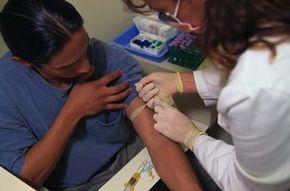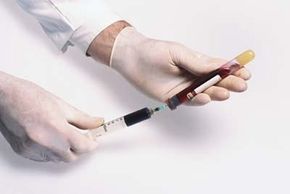In the past, there was some concern over cholesterol tests' accuracy. The debate takes on weight as new technology and an increasing awareness of cholesterol's role in heart disease may soon make such testing in your doctor's office as common as blood-pressure measurements.
In the past, the concern centered on how accurately test results expressed a person's true cholesterol level. Today, laboratories that perform the analyses of blood samples are generally certified so that cholesterol measurements are accurate and reliable. Ask your doctor if the lab used is certified.
A variety of factors can influence the accuracy of your test results, including age, sex, seasonal variations, recent changes in diet or weight, alcohol intake, exercise, family history, other illnesses, pregnancy, and certain medications.
Your age and sex influence your blood-cholesterol level. In childhood, females have higher cholesterol values. Males show a significant decline during adolescence, when testosterone starts flooding their bodies. Adult males over the age of 20, however, generally have higher levels of cholesterol than females. Once women reach menopause, they have higher cholesterol levels than their male counterparts.
Seasonal variation has been shown to affect cholesterol values. In one study, the cholesterol levels of subjects who were not receiving treatment were an average of 7.4 mg/dL higher in December than in June. The reasons for this are still unknown.
Your cholesterol levels are also clearly affected when excessive calories are consumed or your intake of saturated fat and cholesterol is increased. Excess alcohol intake raises your triglyceride levels and HDL levels.
To ensure that your test results are consistent, therefore, you need to have the test performed after you've maintained your usual diet and weight for at least two weeks. In other words, you don't want to have your cholesterol tested the day after Thanksgiving or the day after you quit a diet.
Engaging in vigorous exercise just before your blood test can temporarily lower your cholesterol and triglyceride values, but a vigorous workout can also raise the level of a muscle enzyme called CPK. It's wise, therefore, to take a day off from intense workouts just before you take the test. (On the other hand, regular, vigorous exercise can have a longer-lasting effect by raising HDL and lowering triglyceride levels.)
A personal or family history of certain diseases can also affect your results and your treatment. For example, a family history of elevated lipids is important because genetic forms of high cholesterol often do not respond fully to diet therapy. Yet these disorders increase your risk of heart disease by exposing you to lifelong elevated cholesterol levels. These two points need to be considered when your doctor is deciding how to interpret your test results.
Likewise, a severely elevated cholesterol level (more than 240 mg/dL) that suddenly appears later in life may be caused by a disease that requires treatment before the cholesterol levels can be lowered. Hypothyroidism (due to insufficient amounts of thyroid hormone) is a common secondary cause of elevated cholesterol levels. This disease can be diagnosed by a blood test.
People with poorly controlled diabetes also tend to have high cholesterol levels. Other less commonly found causes include nephrotic syndrome (a kidney disease), obstructive liver disease, and, in rare instances, dysgammaglobulinemia (a disorder of the immune system) and porphyria (a group of metabolic disorders).
Cholesterol values also rise progressively in pregnancy and often take from several months to a year to return to pre-pregnancy levels. It's important for your doctor to know if you could be pregnant, since high cholesterol caused by pregnancy is only temporary and does not warrant treatment -- especially drug therapy -- to get it under control.
Some medications used to treat other medical problems can also affect cholesterol levels. They include medications used to lower blood pressure (hydrochlorothiazide, chlorthalidone, and nonselective beta blockers such as propranolol), estrogen preparations, and anabolic steroids.
In addition to these biologic factors, situational factors must also be considered when your cholesterol values are interpreted. Situational factors that can affect lipid testing include fasting, your posture for the 30 minutes before the blood is drawn, recent surgery, and recent illnesses such as heart attack and infection.
Even your posture before the blood test can affect the values obtained. A blood sample drawn after you've been sitting for 30 minutes will show a higher cholesterol level than a sample drawn when you're lying down. This difference comes into play if you have one test done in a screening program (where you may have been standing or sitting before the test) and a follow-up test performed in a hospital (where you may have been lying down when the test was performed).
Finally, it's widely recognized that cholesterol values fall and triglyceride values rise after a heart attack, major surgery, or extensive burns. When admitted to the hospital for a major vascular event, such as a heart attack or stroke, cholesterol measurements should be taken immediately or within at least 24 hours.
After such an event, LDL-cholesterol levels fall and stay low for weeks. Physicians should then wait at least eight weeks before performing cholesterol measurements. This allows LDL cholesterol to return to a fairly normal level and for the patient to settle on a steady diet and reach a stable weight when the measurements are made.
Practically speaking, there are a few steps you can take to help reduce nonlaboratory errors. Before you have the test done, ask yourself, "Have my diet, exercise patterns, medications, and health been stable for the past two or three weeks?" If the answer is yes, then proceed with the test. If the answer is no, then it may be best to delay the test until these factors have been consistent for at least two weeks.
Before treatment is begun, your doctor will decide whether laboratory studies should be performed to rule out secondary causes of high blood cholesterol. They may include a blood or urine test to rule out pregnancy, a blood test to diagnose hypothyroidism or hyperthyroidism, a urine test to rule out nephrotic syndrome, a fasting blood sugar test to see if diabetes is present, and liver function tests to see if there is evidence of obstructive liver disease.
The evaluation and tests will help your doctor understand the cause of your high blood-cholesterol level and determine how to go about treating it. Diet therapy is considered the cornerstone of cholesterol-controlling therapy. Drug therapy should be considered only when diet therapy has failed to lower your blood cholesterol to an acceptable level (or in rare cases when a quicker and more drastic lowering is essential).
Even then, however, diet therapy must be continued. To monitor your progress in diet or drug therapy, your doctor will periodically test your cholesterol levels.
Now that you know what will happen before, during, and after a cholesterol test, you can follow your doctor's orders to get tested with confidence.
For more information on cholesterol, see:
- Cholesterol Levels: We all know there's "good" and "bad" cholesterol. Find out why you need more of one kind of cholesterol and less of the other.
- Causes of High Cholesterol: Diet and DNA are the main causes of high cholesterol. Learn why the numbers might be high in your case.
- Consequences of High Cholesterol: High cholesterol can lead to a heart attack. Learn more about high cholesterol and heart attack and what other conditions high cholesterol contributes to.
- How to Lower Cholesterol: Like many conditions, eating right and exercising helps control cholesterol. Learn what that means for you.
- How Cholesterol Works: Cholesterol is essential to the body. Find out why we need it and how much is too much.
ABOUT THE AUTHOR
Dr. Neil Stone is a professor of clinical medicine in cardiology at the Feinberg School of Medicine of Northwestern University and a practicing internist-cardiologist-lipidologist at Northwestern Memorial Hospital. He also serves as the Medical Director of the Vascular Center for the Bluhm Cardiovascular Institute. Dr. Stone was a member of the first and third National Cholesterol Education Program Adult Treatment Panels and a past chairman of the American Heart Association Nutrition Committee and Clinical Affairs Committee.
This information is solely for informational purposes. IT IS NOT INTENDED TO PROVIDE MEDICAL ADVICE. Neither the Editors of Consumer Guide (R), Publications International, Ltd., the author nor publisher take responsibility for any possible consequences from any treatment, procedure, exercise, dietary modification, action or application of medication which results from reading or following the information contained in this information. The publication of this information does not constitute the practice of medicine, and this information does not replace the advice of your physician or other health care provider. Before undertaking any course of treatment, the reader must seek the advice of their physician or other health care provider.







